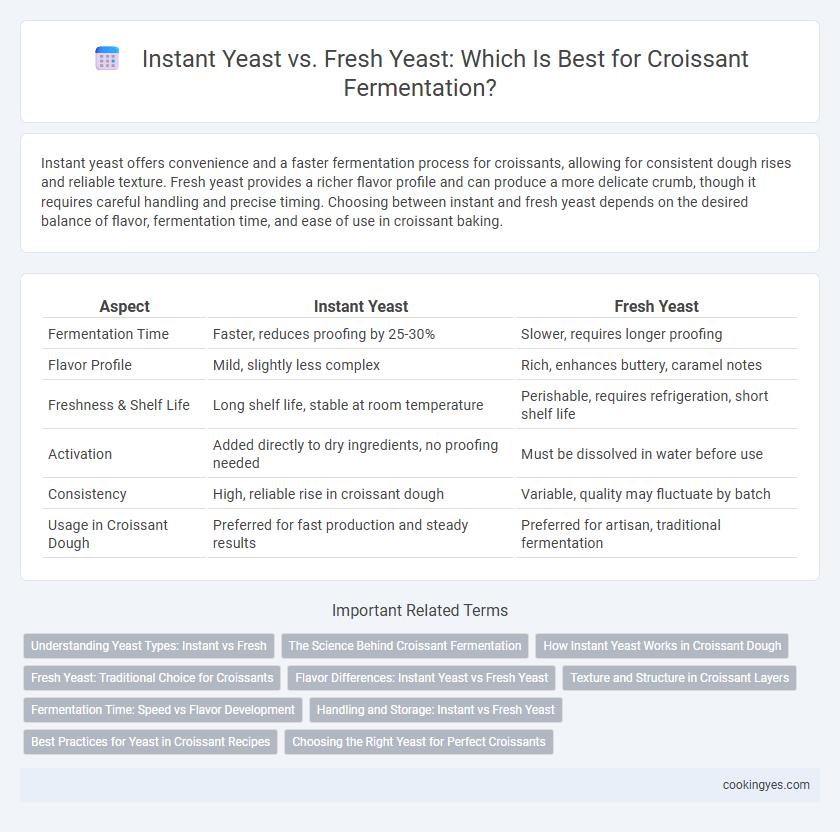Instant yeast offers convenience and a faster fermentation process for croissants, allowing for consistent dough rises and reliable texture. Fresh yeast provides a richer flavor profile and can produce a more delicate crumb, though it requires careful handling and precise timing. Choosing between instant and fresh yeast depends on the desired balance of flavor, fermentation time, and ease of use in croissant baking.
Table of Comparison
| Aspect | Instant Yeast | Fresh Yeast |
|---|---|---|
| Fermentation Time | Faster, reduces proofing by 25-30% | Slower, requires longer proofing |
| Flavor Profile | Mild, slightly less complex | Rich, enhances buttery, caramel notes |
| Freshness & Shelf Life | Long shelf life, stable at room temperature | Perishable, requires refrigeration, short shelf life |
| Activation | Added directly to dry ingredients, no proofing needed | Must be dissolved in water before use |
| Consistency | High, reliable rise in croissant dough | Variable, quality may fluctuate by batch |
| Usage in Croissant Dough | Preferred for fast production and steady results | Preferred for artisan, traditional fermentation |
Understanding Yeast Types: Instant vs Fresh
Instant yeast offers faster fermentation and ease of use, making it ideal for consistent croissant dough rising with less preparation time. Fresh yeast, also known as cake yeast, provides a more delicate flavor and aroma, enhancing the complexity of croissants but requires careful storage and activation. Choosing between instant and fresh yeast impacts fermentation speed, dough texture, and ultimately the flakiness and taste of the final croissant.
The Science Behind Croissant Fermentation
Instant yeast and fresh yeast both play crucial roles in croissant fermentation, influencing the dough's rise, texture, and flavor development. Instant yeast contains more concentrated living cells, enabling faster carbon dioxide production and quicker dough fermentation through rapid sugar metabolism, which impacts the dough's gluten network strength and gas retention. Fresh yeast offers a milder fermentation process with slower carbon dioxide release, allowing more time for enzymatic reactions that enhance croissant dough extensibility and complex flavor profiles through organic acid and ester formation.
How Instant Yeast Works in Croissant Dough
Instant yeast accelerates croissant fermentation by rapidly producing carbon dioxide gas, which creates the necessary air pockets for a flaky texture. Its small granules dissolve quickly in dough, allowing immediate activation without prior proofing, leading to a consistent rise and improved dough elasticity. This efficient fermentation process enhances gluten development and flavor complexity, crucial for achieving the signature layers and lightness of traditional croissants.
Fresh Yeast: Traditional Choice for Croissants
Fresh yeast, known for its moist texture and rich, aromatic fermentation, remains the traditional choice for croissant dough fermentation due to its ability to produce a superior rise and delicate crumb structure. This yeast variety enhances the croissant's flavor complexity by generating natural esters and alcohols during its slow proofing process. Bakers favor fresh yeast for its consistent performance in developing the flaky, buttery layers characteristic of authentic French croissants.
Flavor Differences: Instant Yeast vs Fresh Yeast
Instant yeast produces a slightly less complex flavor in croissant dough due to its rapid fermentation, resulting in milder aromatic compounds. Fresh yeast fermentation generates richer, more nuanced buttery and yeasty notes by allowing longer proofing times and slower enzymatic activity. Bakers seeking deep, traditional croissant flavor often prefer fresh yeast for its impact on taste development and dough texture.
Texture and Structure in Croissant Layers
Instant yeast enhances croissant dough rise rapidly, producing a lighter texture with well-defined airy layers due to its consistent fermentation activity. Fresh yeast offers a more gradual fermentation process, developing a richer flavor and a tender, flaky structure in the croissant layers. The choice between instant and fresh yeast significantly influences the final croissant's texture, with instant yeast favoring flakiness and fresh yeast contributing to a more nuanced crumb structure.
Fermentation Time: Speed vs Flavor Development
Instant yeast accelerates croissant fermentation with shorter proofing times, enabling quicker production cycles ideal for commercial bakeries. Fresh yeast, while requiring longer fermentation periods, promotes superior flavor complexity and a delicate texture due to extended enzymatic activity. Balancing fermentation time and flavor development is crucial for achieving the perfect buttery, flaky croissant profile.
Handling and Storage: Instant vs Fresh Yeast
Instant yeast offers longer shelf life and easier storage as it can be kept at room temperature in a sealed container, making it ideal for home bakers and small operations. Fresh yeast requires refrigeration between 33-38degF (1-3degC) and has a shorter shelf life, typically lasting about two weeks, demanding careful handling to prevent spoilage. Instant yeast's granulated form allows direct mixing with dry ingredients, while fresh yeast needs to be dissolved in water before use, impacting workflow in croissant fermentation.
Best Practices for Yeast in Croissant Recipes
Instant yeast offers consistent rising times and ease of use, making it ideal for home bakers aiming for reliable croissant fermentation. Fresh yeast, favored by traditional French bakers, provides a subtle, complex flavor but requires careful handling and refrigeration. Optimal croissant fermentation involves maintaining dough temperatures around 24-26degC and fermenting for 12-14 hours with fresh yeast for enhanced aroma, while instant yeast may shorten fermentation to 8-10 hours without sacrificing quality.
Choosing the Right Yeast for Perfect Croissants
Instant yeast offers convenience and faster fermentation for croissants, producing consistent dough rise and ideal flakiness. Fresh yeast, prized by artisanal bakers, delivers superior flavor complexity and a tender crumb due to its slower, more controlled fermentation process. Selecting the right yeast depends on balancing production time with desired texture and taste, with instant yeast best for quick batches and fresh yeast preferred for craft-quality croissants.
Instant Yeast vs Fresh Yeast for Croissant Fermentation Infographic

 cookingyes.com
cookingyes.com